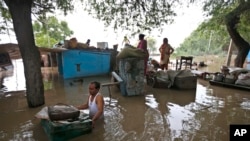NEW DELHI —
Rescue workers in India’s northern Uttarakhand state are trying to reach tens of thousands of people stranded due to landslides and flash floods triggered by heavy rains. At least 150 people have been killed in the Himalayan region, but with access to many areas cut off, there are fears the death toll could be higher.
After bridges were washed away and roads blocked by landslides and flash floods in Uttarakhand, air force helicopters flew to settlements tucked in the high mountains to evacuate people. But the operations were intermittently hampered by bad weather on Thursday.
The scale of the devastation in the Uttarakhand has unfolded slowly after unprecedented heavy rains battered the state, cutting off communication links with many areas. The state’s chief minister Vijay Bahuguna has called it a “Himalayan tsunami” and fears casualties could be very heavy.
Among those stranded are tens of thousands of devotees who were visiting popular Hindu pilgrim spots in the state. Thousands of soldiers have been deployed for the rescue operation.
The director general of Indo-Tibetan Border Police, Ajay Chadha, says roads in some areas, such as the popular Kedarnath temple town, have been completely damaged. He says this is posing a challenge to rescue efforts because they can only be accessed by air.
Chadha says evacuating the stranded people is time consuming because only five people can be brought down by each helicopter sortie. He says that besides air force helicopters, 10 private helicopters are also being used. Chadha says the first priority is to rescue women, children, old people and those who are sick.
Officials say they have identified the worst affected areas and are trying to step up rescue and relief efforts in these regions. Relief camps have been established for people whose homes have been washed away by the rains. Efforts are underway to reach food rations to places to which access is completely cut off.
Harak Singh Rawat, the state’s agriculture minister, says they have distributed 10,000 food packets in some villages and remote areas.
While Uttarakhand has been hardest hit by the heavy rains in Northern India, the neighboring Himachal Pradesh state, also situated in the Himalaya mountains, has also suffered damage.
Several prominent environmentalists have blamed unregulated development in the mountain regions for the destruction unleashed by the rains and say more care needs to be taken to preserve the fragile ecosystem of the Himalayas.
After bridges were washed away and roads blocked by landslides and flash floods in Uttarakhand, air force helicopters flew to settlements tucked in the high mountains to evacuate people. But the operations were intermittently hampered by bad weather on Thursday.
The scale of the devastation in the Uttarakhand has unfolded slowly after unprecedented heavy rains battered the state, cutting off communication links with many areas. The state’s chief minister Vijay Bahuguna has called it a “Himalayan tsunami” and fears casualties could be very heavy.
Among those stranded are tens of thousands of devotees who were visiting popular Hindu pilgrim spots in the state. Thousands of soldiers have been deployed for the rescue operation.
The director general of Indo-Tibetan Border Police, Ajay Chadha, says roads in some areas, such as the popular Kedarnath temple town, have been completely damaged. He says this is posing a challenge to rescue efforts because they can only be accessed by air.
Chadha says evacuating the stranded people is time consuming because only five people can be brought down by each helicopter sortie. He says that besides air force helicopters, 10 private helicopters are also being used. Chadha says the first priority is to rescue women, children, old people and those who are sick.
Officials say they have identified the worst affected areas and are trying to step up rescue and relief efforts in these regions. Relief camps have been established for people whose homes have been washed away by the rains. Efforts are underway to reach food rations to places to which access is completely cut off.
Harak Singh Rawat, the state’s agriculture minister, says they have distributed 10,000 food packets in some villages and remote areas.
While Uttarakhand has been hardest hit by the heavy rains in Northern India, the neighboring Himachal Pradesh state, also situated in the Himalaya mountains, has also suffered damage.
Several prominent environmentalists have blamed unregulated development in the mountain regions for the destruction unleashed by the rains and say more care needs to be taken to preserve the fragile ecosystem of the Himalayas.








